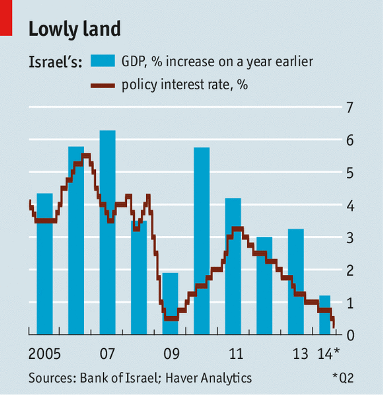ANT KATZ WITH THE ECONOMIST
The following story was first published in THE ECONOMIST on 30 August 2014
Strong shekel hurts economy
Few had seen the cut coming. Bond prices prior to the move had implied that there would be no change in rates for the next three months. The bank had only just cut rates by a quarter of a percentage point the month before, matching the previous record low. Furthermore, the statement accompanying July’s cut had a hawkish tone, implying that the cycle of interest-rate cuts that had begun in September 2011 was at, or near, its end.
The main change since the July meeting has been the Israeli army’s latest incursion into Gaza, in response to rocket attacks on southern Israel. The hostilities have dented consumption, especially in the southern part of the country, near Gaza.
Tourism, which accounts for seven per cent of Israel’s GDP, has slumped throughout the country, ruining this year’s peak summer season. But the Bank of Israel suggests that the fighting, and the drag on the economy it has produced, were not the main reason for the committee’s decision.
Instead the bank noted that inflation was well below its 1 – 3 per cent target and the economy had been slowing across the board. The most recent GDP figures – growth of 1,2 per cent in the second quarter compared with a year before – were anaemic by Israel’s recent standards.
 These unhappy trends may have been aggravated by the hostilities in Gaza, but they long preceded them.
These unhappy trends may have been aggravated by the hostilities in Gaza, but they long preceded them.
Israel’s economy had once seemed indomitable, shrugging off the financial crisis and a series of conflicts with Islamic militants in Gaza and southern Lebanon, among other trials.
But growth has been slowly decelerating since 2011 (SEE CHART, RIGHT).
It remained perky enough to allow unemployment to continue to decline until the end of last year, to a low of 5,7 per cent.
The budget deficit has also been falling, to 2,4 per cent of GDP for the year ending in May – the lowest level since 2007.
Trends seem set to reverse
However, these positive trends have either already reversed, or seem set to do so. The finance minister, for instance, recently admitted that the deficit in next year’s budget will rise to at least 3 per cent.
 Meanwhile, industrial production has shrunk and – most worryingly of all – so have industrial exports. (Israel’s exports – many of them software and IT equipment – account for about 40 per cent of GDP.)
Meanwhile, industrial production has shrunk and – most worryingly of all – so have industrial exports. (Israel’s exports – many of them software and IT equipment – account for about 40 per cent of GDP.)
In part, the slowdown stems from the weakness of the global economy. But another factor behind both the worryingly low rate of inflation and the decline in exports has been the strength of the shekel. The currency has appreciated by 15 per cent since the height of the euro crisis in 2012, as measured by the Bank of Israel’s trade-weighted index.
That strength is tied in large part to buoyant foreign investment, much of it in the form of expensive takeovers of Israeli tech firms. Israel’s nascent production of natural gas, which has cut fuel imports and thus boosted the current-account surplus, has also contributed.
The Bank of Israel has built up $84 billion in foreign reserves resisting the shekel’s rise. But its preferred weapon against the currency’s appreciation has been a long series of interest-rate cuts, initiated under the previous governor, Stanley Fischer (now deputy chairman of the Federal Reserve), and continued under his successor, Karnit Flug.
Low interest rates, however, are fuelling a giddy rise in house prices, as in so many other countries. In that respect, the run of disappointing economic news may come as something of a relief to the Bank of Israel. It appears to have diminished the shekel’s value somewhat – setting the stage, with luck, for a recovery in exports.
Denis Solomons
Sep 1, 2014 at 7:13 am
‘Israel has to capitalise on the Dead Sea and Dead Sea products ( Ahava !)
The dead sea mud is thought to be the answer and panacea to psorisis and other chronic skin disorders e.g. chronic eczema.
The black dead sea mud is used in facial masks and if applied correctly is purported to have a similair effect to face -lifts and skin jejuvenation techniques.
a recent study published in the New england Journal of Medicine showed similair results for botox for wrinkles and face mud packs made from the Dead Sea !
A lot of chronic skin disorders respond to the high saline cotent and bacteria-free blend obtained from the soil of the Dead Sea !’